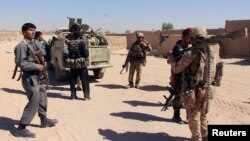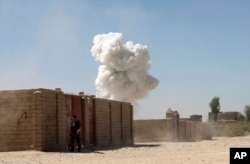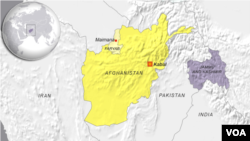Security forces in Afghanistan claim to have pushed the Taliban from parts of a key southern provincial capital and inflicted heavy casualties on the opposition as insurgent hostilities appear to have subsided in other conflict-hit provinces.
The rebel group staged a major assault on Lashkar Gah, capital of Helmand province, a week ago, forcing their way into parts of the nearly besieged city.
Dozens of Afghan troops were killed in the ensuing days of clashes with many more wounded, prompting the U.S. military to conduct airstrikes in support of government forces.
The security forces have retaken some areas they lost to the Taliban with the support of artillery and airpower, the provincial governor told VOA Sunday.
The offensive killed 88 Taliban fighters, including foreigners, while about 90 of them were wounded, claimed Hayatullah Hayat.
“A number of explosives-packed vehicle prepared for suicide attacks were also destroyed,” the governor asserted.
Security officials say that sporadic clashes were continuing in the area.
Taliban offensive
Some provincial officials told local and foreign media that Afghan forces lost more than 100 personnel since Monday when the Taliban launched its offensive on Lashkar Gah, while dozens more have gone missing. Afghan Defense Ministry officials disputed the figures, but have declined to release a casualty toll.
The government is said to be in full control of only a few of the 14 districts in Helmand, the largest of all 34 Afghan provinces. A Taliban spokesman has denied official claims, saying its fighters have not retreated from their positions and are making further advances in Lashkar Gah.
Commander of the U.S.-led foreign forces, General John Nicholson, said Saturday the Taliban has been attempting to seize control of an Afghan provincial capital before the end of the fighting season.
“Since they began their offensive in April they have not accomplished any of their objectives,” the general said during a visit to the western province of Farah. He added that attacks on Lashkar Gah, Tarin Kot, the capital of southern Uruzgan province, and the key northern city of Kunduz are all part of the insurgent campaign.
WATCH: General John Nicholson
The Taliban briefly captured Kunduz in the 2015 fighting season, dealing a blow to internationally-trained Afghan security forces. Earlier this month, the insurgents fought their way into the provincial capital and seized ground before they were evicted from Kunduz this past Thursday.
“They are frankly trying very hard at the end of the year to try and seize a city before the year is over. But this will fail because it gives us an opportunity to target them in large numbers to defeat them in the vicinity of these cities and to reassure the people of Afghanistan that we are with them,” vowed Nicholson.
Intense fighting was reported in the northern Faryab province Sunday, but observers noted an abrupt decline in Taliban attacks particularly in southern and southeastern provinces that are known as their heartlands. The onset of winter and heavy casualties inflicted on Taliban fighters by Afghan forces with the support of U.S. airstrikes are being cited as possible factors for reduction in the hostilities.

















